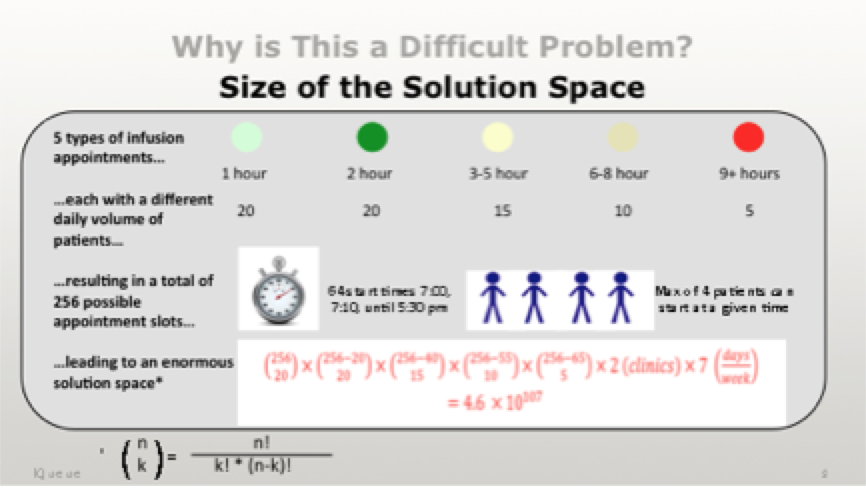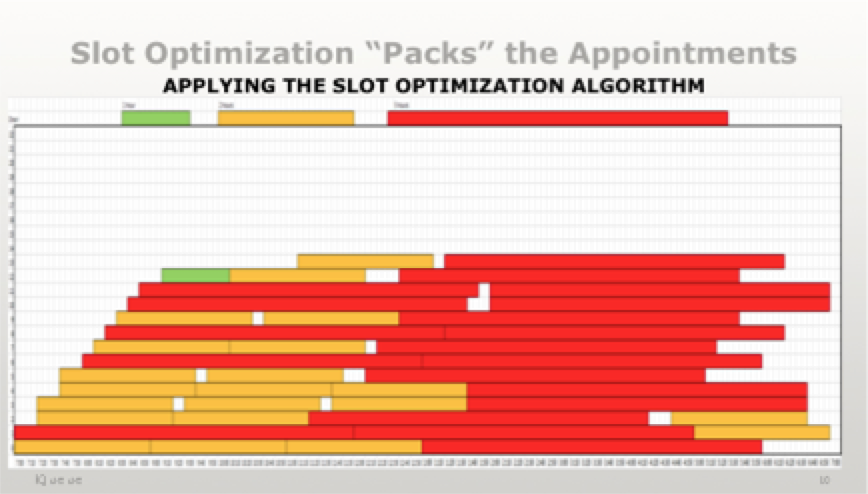Do you ever wonder why we all wait for a long time to see our doctor?
The root cause is that the healthcare scheduling system is broken. Hospitals are using a calculator and standard electronic health record templates to solve a math problem that needs a cluster of servers and data scientists to solve it.
Most EHRs use scheduling templates provided by their EMR that have no real intelligence built in for scheduling patients. In their desire to be patient-centric, they typically subscribe to a "first-come, first-served" methodology and use gut-based rules of thumb to accommodate patient and staff needs for a particular "appointment slot." What results, in effect, is the opposite of a patient-centric situation—a domino effect of longer wait times and unhappy patients and doctors.

Patient scheduling is a very complex math problem ...
To illustrate the complexity of the problem, let's take a look at a medium-sized U.S. cancer treatment center with 15-20 chairs serving 50 patients per day. The size of the solution space to derive an optimal appointment scheduling template can quickly get extremely large—so large that it cannot be computed using conventional approaches such as Excel.
Assume the center schedules patients every 15 minutes starting at 8:00 a.m. with a last appointment offered at 5:30 p.m. In this case, there are 39 time slots. Assume that the center can accommodate three simultaneous starts due to the nursing workload of getting a patient situated. Hence, there are 117 potential appointment slots, which is calculated as 39 times 3.
Assume three different lengths of treatments of 1-2 hours, 3-4 hours and 5+ hours and a typical daily mix of patients for those three types of treatments of 25, 15 and 10 patients, respectively.
Fitting the first block of 25 patients into the 117 potential slots can be done in "2.0576 times 10 to the 25th power" [117 choose 25] unique ways.
This is calculated using the formula:

Having placed the first 25 patients into the 117 slots, there are now 92 slots remaining in which to place the next group of 15 patients. This can be done "6.5516 times 10 to the 16th power" [92 choose 15] unique ways.
Finally, the last group of 10 patients needs to be placed, and there are 77 slots remaining. Therefore, they can be placed in "1.09699 times 10 to the 12th power" [77 choose 10] unique ways.
Multiplying all three configuration sets provides the number of ways in which the schedule for a typical 50-patient day can be accommodated at 15-minute intervals with three simultaneous starts. Therefore, the size of the solution space is 1.478 times 10 to the 54th power.
With a solution space being represented by a number that has 54 zeroes, it is clear that simple Excel-based or traditional EHR approaches can never create an optimal solution for scheduling appointments.
Now, compound the scope of possible appointments with the reality of hospital variables, such as practitioner schedules, staff changes, patterns of demand, equipment maintenance, room availability, lab results and clinical trial events, and you can see why this becomes a very difficult formula to solve with simple math—and you continue to wait, wait and wait some more.
... Ready to be solved
Inspired by the likes of Toyota and just-in-time lean manufacturing practices, data science and mathematics are changing the face of healthcare scheduling and, in effect, making healthcare more accessible to more patients.

By taking a holistic review, data scientists are mining all scheduling patterns and possibilities specific to a center, as well as considering operational constraints across patient demand, practitioner and staffing schedules, and capital asset availability. From there, an algorithm is created that optimizes a schedule for the center to serve patients more uniformly throughout the day, versus the peaks and valleys of traditional scheduling systems. The end result promises more patients served, reduced cost of service, optimized equipment and facility utilization, and a whole lot less sitting in the waiting room.
Mohan Giridharadas is founder and CEO at LeanTaaS. Before starting LeanTaaS, Mohan led the Manufacturing and Service Operations practice at McKinsey & Co. in the U.S. and the Asia-Pacific region. He is on the faculty of the Continuing Studies program at Stanford University and the MBA program at the Haas School of Business at UC Berkeley. He holds an MBA from Stanford University, an MS in Computer Science from Georgia Tech and a B Tech. in Electrical Engineering from IIT Bombay. For more information on LeanTaaS, please visit http://www.leantaas.com..


